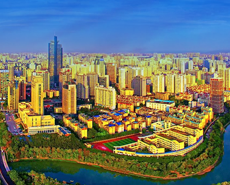
Tellurium metal industry still in need of new opportunities
----Interview with Mr. He Gang, general manager of Xiangtan Churun Tellurium Industry Co., Ltd.
Asian Metal: Thanks for taking our interview. Would you please give a brief introduction on yourself and your company?
Mr. He: Since I graduated from Hunan University in 1990, I had been working in Hunan Zhuzhou Smelter Group until 2003. Then in 2005 I graduated from Central South University with the MBA degree, and also in that year I began to work as the executive board member of our company, Xiangtan Churun Tellurium Industry Co., Ltd., in charge of the company operation until today.
Xiangtan Churun Tellurium Industry was founded by my father, Mr. He Guozhang. He graduated from Changsha Institute of Mining and Metallurgy and then worked for Zhuzhou Smelter Group for some time. Upon leaving Zhuzhou Smelter Group in early 1990s, he set up our company. From 1991 on we began to produce tellurium metal and by around the year of 1997 we had completely grasped the production technology, with the hydrometallurgy technique totally used in our production. In the early years, we could produce only 3-5t of the metal and our annual production capacity kept increasing to 20t. In addition, before 2002 we could afford to produce only in rented workshops. With our financial strength improving, we built in Xiangtan county our own factory which occupies nearly 9,000m2. During the process, we also strengthened our environmental protection efforts and undertook technical upgrade so as to better control microelement contents in our products. Now, we are able to realize an annual capacity of 60t of tellurium metal.
Asian Metal: Would you please give a general picture of the tellurium metal industry at present? What are the major stakeholders in the market?
Mr. He: Generally speaking, Jiangxi Copper Corporation is the most typical enterprise in the tellurium industry in China, while in terms of private company, our company is a typical one. And other major enterprises include Vital Materials, Jinrun Group and Appollo. The major industries consuming tellurium metal include solar energy, thermoelectric refrigeration and metallurgy, but in China the refrigeration industry consumes the most of tellurium metal. And most consumers are located in Hebei, Zhejiang, Hangzhou, Henan and Guangdong.
Asian Metal: Prices for tellurium metal have been continuously dropping over nearly the past ten years. Do you think that prices in 2015 hit the lowest point in history?
Mr. He: Historically speaking, prices for tellurium metal experienced extreme fluctuations, once soaring from RMB180,000/t to RMB3 million per ton, and also falling back to around RMB200,000/t. I personally feel that prices in 2015 were the lowest point, considering costs of raw material and production.
Asian Metal: What are the usages of tellurium metal? How much do the refrigeration and CdTe solar energy industries consume respectively? How about the tellurium-copper ally industry? How do you think of the tellurium market in the future?
Mr. He: On outlook, it is not so inspiring for the refrigeration industry if we do not seek to expand our shares in overseas markets. But nevertheless, it is still the industry that consumes the most of tellurium metal. As for cadmium-tellurium and tellurium alloy, domestic consumption of the two materials are still at a low level. Considering the current situation, we feel that if there are no new application fields to be developed for the tellurium industry or government does not give necessary policy supports, China’s tellurium metal industry won’t see great changes. At present, application of sporadic solar energy systems is prevailing in China and so the domestic solar energy industry still focuses upon silicon-based solar energy, while application of IGS and CdTe solar energy systems is not very popular. In addition, though Appollo has been purchased by China State Construction Engineering Corporation, in the short term there will be no large-scale increases in demand incurring for the tellurium metal industry.
Asian Metal: Insiders hold that globally speaking, stocks of tellurium metal in the market are of great quantity while consumption of the material is limited. Thus it’s quite urgent for the industry to develop new fields of application. Do you have any idea that how much stocks are at present and when they will be released into the market?
Mr. He: At present in China, Jiangxi Copper Corporation maintains the largest output of tellurium metal, which is mostly produced by its Dexing copper mine. Besides, raw materials for producing tellurium metal include associate ores of lead, zinc, gold and silver, as well as raw ores of the metal which has not come into large-scale production yet. Quantity of raw materials for tellurium metal production is estimated to be dwindling gradually.
Tellurium metal stocks you mention just now should be that of processed tellurium metal 99.99%. The production cycle for tellurium metal is relatively long, about 40-50 days. In the previous years when prices kept dropping, some producers suffered continuous losses as they signed long-term orders and follow-up restocking of their customers. So I believe that produces which could afford selling their stocks at low prices have already done so, and at present those with no capital pressure are expected not to release their stocks into the market immediately. In addition, previously Fanya Nonferrous Metals Exchange also purchased tellurium metal in the market, and its stocks are estimated to be 200t or even around 1,000t according to some sources. By 2010, China had an annual output of around 300t and Jiangxi Copper Corporation had an output of 60-70tpy. What I can say is that stocks at present are of large quantities but I am not sure about the specific figure.
Asian Metal: Would you please give a brief introduction about your outputs and products at present?
Mr. He: Our outputs are small at present as prices hover at a low level, only 10-20tpy. Our products have the following indicators:
















